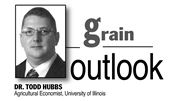Implications Of The Prospective Planting Acreage And Grain Stocks For Corn And Soybeans

On March 31, the USDA released the Prospective Plantings and Grain Stocks reports. The Grain Stocks report gives an opportunity to assess the pace of consumption for corn and soybeans during the current marketing year. The Prospective Plantings report provides the first indication of the potential size of corn and soybean crops during 2017. The following discussion recaps the information in corn and soybean markets provided in the reports and the price implications associated with them.
March 1 corn stocks were estimated at 8.62 billion bushels. The stocks estimate allows for a calculation of feed and residual use of corn during the second quarter of the 2016-17 marketing year. Total disappearance during the quarter was 3.77 billion bushels. Estimates of corn exports during the quarter are at 552 million bushels. Corn used for ethanol and co-product production during the quarter totaled 1.386 billion bushels. Corn processed domestically for other food and industrial products was likely near 360 million bushels.
The remaining disappearance, estimated at 1.482 billion bushels, consists of the feed and residual category. Feed and residual use during the first half of the marketing year are estimated at 3.776 billion bushels. Feed and residual use during the first half of the year last year accounted for 68.0 percent of the marketing year total of 5.550 billion bushels. Based on current stocks estimates, it appears feed and residual use this year may not reach the projection of 5.550 billion bushels and could be adjusted by USDA in the next WASDE report.
March 1 soybean stocks estimates indicated 1.73 billion bushels, which came in above trade expectations. The stocks estimate allows for a calculation of seed and residual use of soybeans during the second quarter of the 2016-17 marketing year. Total disappearance during the first half of the marketing year was 2.78 billion bushels. Exports during the first half of the marketing year are estimated at 1.65 billion bushels. Soybean crush during the first half totaled 976 million bushels. Seed and residual use calculations proceed from the remaining disappearance adjusted for soybean imports. Seed and residual use for the first half of the marketing year are estimated at 158.1 million bushels.
Corn producers reported intentions to plant 90.0 million acres of corn this year, 4.0 million less than planted last year. Soybean planting intentions indicated farmers plan to plant 89.5 million acres of soybeans. The soybean acreage intentions came in at the high end of market expectations. This switch is particularly prominent in the western Corn Belt. North Dakota, South Dakota, Nebraska, Minnesota, and Kansas each produced record high soybean acreage planting intentions. The current harvest futures price ratio between corn and soybeans sits at 2.44. The current price ratio is significantly lower than the 2.57 level on March 1 before the survey on planting intentions commenced. Depending on field conditions in during the planting season, the changing price relationship suggests that some producers could plant more corn acreage than reported in March but it requires a significant shift in the current price ratio relationship. The June Acreage report will provide more clarification.
In addition to the allocation of acreage to particular crops, the magnitude of total principal crop acreage shows a 2.3 million acre decrease from 2016. The USDA estimates that acreage planted to principal crops in 2017 will total 316.9 million acres. The planned reduction in total planted acreage from that of a year ago is particularly acute in feed grain crops. Sorghum acreage is projected to be 933,000 acres lower than a year ago at 5.76 million acres. Winter wheat acreage decreased 3.4 million acres to 32.74 million acres. Barley and oats decreased by 504,000 and 119,000 acres respectively. The lower levels of prospective planting for feed grains in 2017 highlights the importance of yields in 2017 as a key factor in feed grain prices.
The high March 1 stock numbers provide some bearish sentiment for old crop corn and soybean prices in 2017. The larger than expected soybean stock number may have some implications for the size of the 2016 soybean crop, but the final estimate will not be known until September. The large corn stocks number impact the consumption of corn in the feed and residual category directly during the current marketing year and an expectation of reduced feed and residual use is prudent moving forward. Planting intentions confirmed the belief that farmers would switch to soybean production in 2017. The large Brazilian soybean crop this year combined with stable demand over the next marketing year gives an indication of lower prices for soybeans next marketing year. The lower corn planting intentions provide some support for corn prices despite the large March 1 stock estimate. If consumption maintains its current pace, the 2017-18 marketing year should see stable to higher corn prices. ∆
DR. TODD HUBBS: Agricultural Economist, University of Illinois